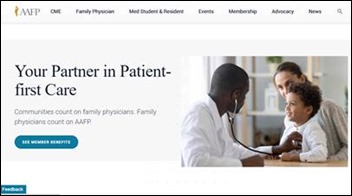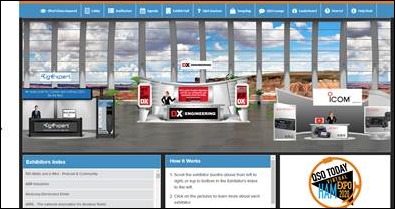EPtalk by Dr. Jayne 8/27/20
Telemedicine provider Avera ECARE creates the American Board of Telehealth, positioning it as a national body to develop best practices and standards for telehealth education. The new board plans to focus on telehealth quality and education across the scope of individuals involved in telehealth, from administrators to physicians and everywhere in between. The ABT’s advisory board includes leadership from industry players such as Amwell and the American Telemedicine Association (ATA), along with a couple of academic faculty.
Avera received a $4.3 million grant from the Leona M. and Harry B. Helmsley Charitable Trust last year, which funded a telehealth education center along with a certificate program. The new ABT program will launch online September 7 with a CORE (Clinical, Operational, Regulatory, and Ethics) Concepts in Telehealth Certificate Program. Validated guidelines will be supplied through the Harvard medical Physician Faculty Group and the curriculum will be delivered using seven online modules. I’ve been underwhelmed by previous educational opportunities from the ATA and telehealth vendors, so my curiosity sent me to check out the website. There’s a $400 fee for the program and it sounds like they will mail you a handsome certificate, since they note that there is a $150 fee for a replacement.
My wacky clinical story of the week comes courtesy of our broken healthcare system, because if it was functional, the visit would never have happened. A patient presented to a direct-to-consumer telehealth service after seeing her primary care physician, who referred her to a subspecialist, who recommended a course of treatment that the patient didn’t feel was working. She was unable to reach the subspecialist due to limited office hours, so she called telehealth for a “second opinion.” It never occurred to her to reach back out to her primary physician to further discuss it. She ended up on the phone with an emergency medicine physician who wasn’t able to assist due to both limitations of knowledge and the constraints of his scope of service. Operations people take note: technology is not the answer here (but it can help).

Doing what I do for HIStalk is a great excuse to spend time every week checking out new companies. Sometimes a friend clues me in on an interesting thing they’ve seen, or mentions a need that gets me questioning whether a solution exists. Such was the case this week with SS&C’s Vidado platform, which was formerly under the Captricity moniker. Apparently they are a player in the insurance and financial services sector, with clients such as MetLife and Guardian. They have a track record with OCR and data extraction of insurance history and medical forms, which gives support to their entry into the world of healthcare. They processed over 300 million pages last year and obviously can play at scale.
It looks like their healthcare focus includes drug prior authorizations and specialty pharmacy orders, along with common documents such as claims forms. It sounds like they have a short-term proof of accuracy offer that allows clients to see how the solution would handle their forms before signing on the dotted line. If I was looking for a vendor in the space, that would certainly be compelling. I’ll certainly be keeping my eye on them to see how they fare in the wacky world of healthcare.
There are still plenty of paper forms out there, as I learned at the imaging center last week. They are now two years into their Epic implementation and are still handing patients a paper form to complete that looks like a downtime document – it doesn’t even have the patient’s name or demographics on it. Forms that make you fill out your address when it’s already in the registration system, EHR, and RCM system are just annoying.
One of my favorite techies has been out of work for a while and reached out today to share his acceptance of a new position. He’s been to hell and back in his job search and we caught up about some of the strange behaviors he’s seen among recruiters and hiring managers. One disheartening tale involved a recruiter who reached out twice for the same position, missing the fact that she had previously told him he wasn’t selected to move to the next step. Another involved a manager who noted that he was the first to interview for the position, but they planned to conduct interviews for the better part of a month, so he shouldn’t expect a decision any time soon. Nothing says “we don’t know what we’re looking for” like an admission that you haven’t narrowed your candidate pool.
My friend noted that multiple people asked questions like “why have you been out of work for so long” as if they were unaware of major layoffs in the healthcare IT industry or a global pandemic that has eliminated hiring in many sectors for the last six months. Not to mention that people may have been impacted by COVID personally or with the illness or loss of a family member, so it’s just not that great of a question. I’ve always found it better to focus on what the candidate is bringing to the table rather than the circumstances that led them there.
Regardless, I’m glad he found a position that seems like a good fit and that happens to be in his favorite industry. The fact that it’s work-from-home well into 2021 is a bonus, too. I know there are millions of good people looking for work right now and I wish them productive interviews with companies that have their acts together.

Everyone falls victim to clickbait headlines. I have to admit I was pulled into this viewpoint article in Nature Reviews Urology. “Making love in the time of corona – considering relationships in lockdown” looks at impact of societal lockdowns on intimacy. Topics range from the practical to the philosophical, so if you’re looking for an interesting read, it certainly fits the bill.
What’s the worst clickbait headline you’ve ever fallen for? Leave a message or email me.

Email Dr. Jayne.




























The CEO sentenced to jail for massive healthcare fraud will get pardoned in a week.